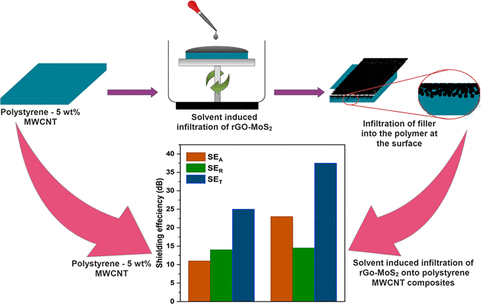当前位置:
X-MOL 学术
›
ACS Appl. Nano Mater.
›
论文详情
Our official English website, www.x-mol.net, welcomes your
feedback! (Note: you will need to create a separate account there.)
Nanoinfiltration for Enhancing Microwave Attenuation in Polystyrene–Nanoparticle Composites
ACS Applied Nano Materials ( IF 5.3 ) Pub Date : 2020-01-31 , DOI: 10.1021/acsanm.9b02521 Jagadeshvaran P L 1 , Harsha Nallabothula 1 , Aishwarya V. Menon 2 , Suryasarathi Bose 1
ACS Applied Nano Materials ( IF 5.3 ) Pub Date : 2020-01-31 , DOI: 10.1021/acsanm.9b02521 Jagadeshvaran P L 1 , Harsha Nallabothula 1 , Aishwarya V. Menon 2 , Suryasarathi Bose 1
Affiliation

|
Polymer-based composites have emerged as promising candidates for microwave attenuation. It is now understood that, in order to enhance this attenuation, the amount of functional nanoparticles in the system has to be very high. However, this is limited by the processing challenges because the mixing parameters affect the way the nanoparticles are dispersed in a polymer nanocomposite. Although it is possible to achieve good mixing with the help of current state-of-art technology, the maximum amount of nanoparticles that can be incorporated is limited by several factors. Herein, a unique strategy (nanoinfiltration) is described to increase the filler concentration based on the dynamics of polymer chains in the presence of a solvent that is reported for increasing the filler concentration. Upon spin coating of a polymer solution containing well-dispersed nanoparticles, the solvent causes the polymer to swell, thereby increasing the available free volume where the nanoparticles can get trapped. Interesting morphologies were observed when nanoparticles of different shapes [spherelike Fe3O4, rodlike multiwalled carbon nanotubes (MWCNTs), and sheetlike graphene oxide (GO) and also hybrid structures like reduced graphene oxide, rGO–Fe3O4 and rGO–MoS2 were spin-coated. This establishes a strong correlation between the morphology of the nanoparticles and the free volume and characteristic length of the polymer chain. This approach was extended to design conducting nanocomposites in order to explore them for EMI shielding applications. Herein, we have employed nanoinfiltration to embed different nanoparticles into a composite of recycled polystyrene with multiwalled carbon nanotube (PS–MWCNT). It was observed that the shielding effectiveness of PS–MWCNT was enhanced up to −35 dB after being subjected to nanoinfiltration with rGO–MoS2. In order to evaluate the efficacy of this strategy, PS–MWCNT was sandwiched between two sheets of porous poly(vinylidene fluoride) containing rGO–MoS2. In doing so, a sharp decrease in the value of the EMI shielding effectiveness was observed. This hence suggests that nanoinfiltration proves to be a useful tool to enhance the radiation shielding property of conducting nanocomposites.
中文翻译:

纳米渗透增强聚苯乙烯-纳米颗粒复合材料的微波衰减
聚合物基复合材料已成为微波衰减的有希望的候选者。现在可以理解,为了增强这种衰减,系统中功能性纳米粒子的数量必须非常高。然而,这受到加工挑战的限制,因为混合参数影响纳米颗粒在聚合物纳米复合材料中的分散方式。尽管可以借助当前的最新技术实现良好的混合,但是可以结合的纳米颗粒的最大数量受到几个因素的限制。本文中,描述了独特的策略(纳米渗透),其在存在溶剂的情况下基于聚合物链的动力学来增加填料浓度,据报道该溶剂用于增加填料浓度。在旋涂包含良好分散的纳米颗粒的聚合物溶液时,溶剂会使聚合物溶胀,从而增加了可用的自由体积,纳米颗粒可被捕获。当不同形状的纳米颗粒[球形Fe时,观察到有趣的形态3 O 4,棒状多壁碳纳米管(MWCNT)和片状氧化石墨烯(GO)以及混合结构,如还原氧化石墨烯,rGO–Fe 3 O 4和rGO–MoS 2 被旋涂。这在纳米颗粒的形态与聚合物链的自由体积和特征长度之间建立了很强的相关性。该方法已扩展到设计导电纳米复合材料,以探索其在EMI屏蔽应用中的应用。在这里,我们利用纳米渗透将不同的纳米颗粒嵌入到具有多壁碳纳米管(PS-MWCNT)的回收聚苯乙烯复合材料中。观察到,用rGO-MoS 2进行纳米浸润后,PS-MWCNT的屏蔽效果提高到-35 dB 。为了评估该策略的有效性,将PS-MWCNT夹在两片含rGO-MoS 2的多孔聚偏二氟乙烯之间。这样做时,观察到EMI屏蔽效果的值急剧下降。因此,这表明纳米渗透被证明是增强导电纳米复合材料的辐射屏蔽性能的有用工具。
更新日期:2020-01-31
中文翻译:

纳米渗透增强聚苯乙烯-纳米颗粒复合材料的微波衰减
聚合物基复合材料已成为微波衰减的有希望的候选者。现在可以理解,为了增强这种衰减,系统中功能性纳米粒子的数量必须非常高。然而,这受到加工挑战的限制,因为混合参数影响纳米颗粒在聚合物纳米复合材料中的分散方式。尽管可以借助当前的最新技术实现良好的混合,但是可以结合的纳米颗粒的最大数量受到几个因素的限制。本文中,描述了独特的策略(纳米渗透),其在存在溶剂的情况下基于聚合物链的动力学来增加填料浓度,据报道该溶剂用于增加填料浓度。在旋涂包含良好分散的纳米颗粒的聚合物溶液时,溶剂会使聚合物溶胀,从而增加了可用的自由体积,纳米颗粒可被捕获。当不同形状的纳米颗粒[球形Fe时,观察到有趣的形态3 O 4,棒状多壁碳纳米管(MWCNT)和片状氧化石墨烯(GO)以及混合结构,如还原氧化石墨烯,rGO–Fe 3 O 4和rGO–MoS 2 被旋涂。这在纳米颗粒的形态与聚合物链的自由体积和特征长度之间建立了很强的相关性。该方法已扩展到设计导电纳米复合材料,以探索其在EMI屏蔽应用中的应用。在这里,我们利用纳米渗透将不同的纳米颗粒嵌入到具有多壁碳纳米管(PS-MWCNT)的回收聚苯乙烯复合材料中。观察到,用rGO-MoS 2进行纳米浸润后,PS-MWCNT的屏蔽效果提高到-35 dB 。为了评估该策略的有效性,将PS-MWCNT夹在两片含rGO-MoS 2的多孔聚偏二氟乙烯之间。这样做时,观察到EMI屏蔽效果的值急剧下降。因此,这表明纳米渗透被证明是增强导电纳米复合材料的辐射屏蔽性能的有用工具。











































 京公网安备 11010802027423号
京公网安备 11010802027423号